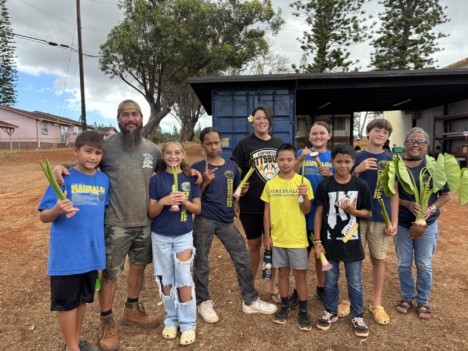Planting Pilina: Maunaloa Students Connect to Culture through Kalo

Kindergarten students are seen here learning the different parts of the kalo leaf with Josh Pastrana. Photo by Janavi Pelekai Pre-K students with Kumu Healani plant their kalo with uncle Josh Pastrana and aunty Ayanna. Photo by Janavi Pelekai Each student in Kumu Espaniola’s class had the opportunity to prepare their huli before planting with Josh Pastrana. Aunty Jessica Akaka was proud about what the students prepared, and Aunty Laura displayed the moi kalo before planting. Photo by Janavi Pelekai
Communiy contributed
By ʻIolani Kuoha, Maunaloa Elementary School Temporary Vice Principal
At Maunaloa Elementary School, the foundation of learning is rooted not only in books and lessons, but also in ʻāina. On a recent morning filled with mana and mud, every student had the opportunity to plant their own kalo, participating in a powerful cultural and educational experience made possible through the generosity of our community.
Thanks to the support of local kalo farmer Josh Pastrana, students were introduced to a variety of kalo; moi, ʻeleʻele naioea and kapaʻaloa. Students also learned about the deeper meaning of Haloa — the first child of Wākea and Hoʻohōkūkalani in the Kumulipo — and the spiritual elder sibling to kanaka. Pastrana shared this origin story and demonstrated traditional planting techniques, helping students understand how and why we plant kalo.
This event was scheduled during the Kū Kahi moon phase, a time associated with strength, leadership and upright growth — ideal for crops like kalo. Just as Kū stands tall, so do our keiki, grounded in values and culture, reaching toward their fullest potential.
“We planted more than kalo — we planted purpose,” Principal Kimberly Kaʻai said. “It was beautiful to see each child engage with the ʻāina and walk away with a deeper understanding of where they come from.”
Kū Kahi is more than a moon phase — it is a time for setting intentions, taking bold steps forward, and rooting ourselves in collective strength. As our students planted, they cultivated values: patience, perseverance, responsibility and pride in being stewards of this land.
A Hawaiian proverb says “E ola ka ʻāina, e ola kākou,” or “When the land lives, we live.”
The kalo huli were lovingly donated by Pastrana and Jorgen and Malia Busby of Haloa o Honouliwai. Sheldon and Jeannie Hamakua of Kaulu Farms, and the Kuoha ʻOhana were community partners who helped prepare the school’s māla, generously sharing their ʻike and aloha.
“We believe in the next generation,” program organizer Kahana Pele said. “This kind of hands-on learning gives our keiki a chance to engage in real-world cultural practice while building a strong sense of kuleana.”
Throughout the day, students rotated through the māla in by grade level, guided by teachers and supported by staff. Laughter, curiosity, and muddy hands filled the air as each child pressed their huli into the soil — some for the very first time. Faculty and staff joined in, strengthening pilina (relationships) and modeling what it means to be part of a caring, learning ʻohana.
As we continue to grow our vision of a thriving ahupuaʻa, we extend deep mahalo to our partners, teachers, and ʻohana who helped bring this experience to life. At Maunaloa Elementary, we don’t just teach from the land — we learn with it. Stay tuned for our next Pilina project, where workshops will be conducted to build papa kuʻi ʻai (poi board) and pōhaku kuʻi ʻai (poi pounder) — deepening their connection to ʻāina, culture, and the full cycle of kalo.











Don't have a Molokai Dispatch ID?
Sign up is easy. Sign up now
You must login to post a comment.
Lost Password